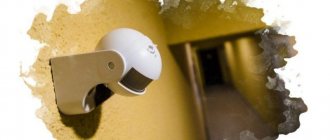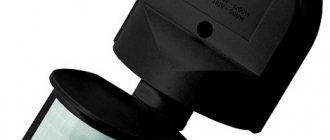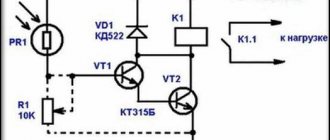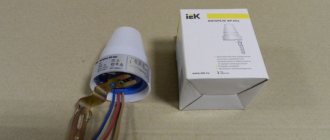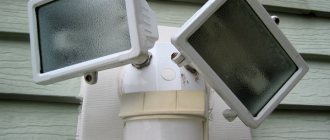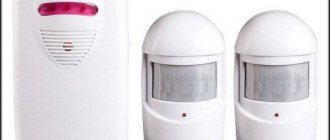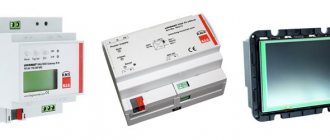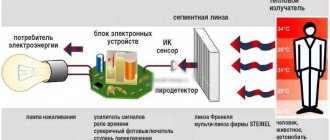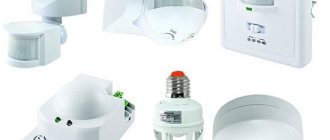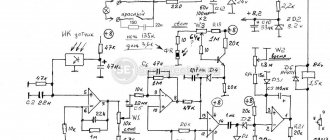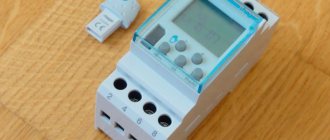Just don't think anything bad! I'm not so lazy that I'm too lazy to reach out to turn on the light. It’s just that “these valiant builders,” as always, got everything mixed up. They installed the switch so inconveniently that it is easier to wash your hands in the dark than to stomp to the end of the corridor, turn on the light, then stomp back, and so on every time. The household members were arguing, and I myself, to admit, was not happy with this situation. And then suddenly I thought: “ I'll buy myself a motion sensor, I’ll put it in the bathroom, let it turn on the light when someone comes in, and then turn it off.” With this saving thought, I went to the electrical goods store and returned from there with a magic box. I’m ready to tell you what came out of my idea.
Any self-respecting electrical store will offer you several sensor options to choose from. There are separate devices, and some combined with a spotlight or a simple lamp. There are those who “take” only a short distance, others “reach from fence to fence.”
My case is just one of the options for using motion sensors. For example, you can install them in your summer cottage and connect them with floodlights. As soon as someone goes out into the yard, it immediately becomes light. Can you imagine what a surprise awaits someone who climbs over the fence in the hope of stealing something valuable from you? Let's say, dig up your pride - tomato seedlings.
If you complement the system of motion sensors and spotlights with a couple of good Rottweilers released into the garden at night, then you will only have to watch through the window as the unlucky gentleman of fortune runs away from the ferocious dogs who finally overtake him at the moment of climbing over the fence and commit the classic act of tearing his pants .
Seriously speaking, motion sensors can significantly reduce energy costs , you just have to start using them wisely. Not to mention, they are indispensable assistants in the design of security systems and other interesting engineering solutions.
What are the types and types of sensors?
Motion sensors for lighting come in 2 types: active, passive. Active DDs constantly monitor the room. These include microwave and ultrasonic devices.
In the first case, the device responds to sound waves, after receiving which the contacts close and the lamp lights up. The advantage of microwave devices is that they pick up the signal even through walls or other obstacles. They are more in demand at sites under protection. Such devices can work together with a video camera. But there is also a drawback - an increased likelihood of a false response.
Ultrasonic devices are less popular among users. They emit waves that have a negative effect on the human body with prolonged exposure.
Infrared motion sensors to turn on the lights on the stairs respond to heat. They can be active or passive. In the first embodiment, the receiving element and the transmitter are installed in different places. When the signal between them breaks, the contacts close and the light comes on. In the second case, the devices monitor the external temperature.
Passive devices also include acoustic devices that respond to conversation, clap and other noise effects. There are mixed options, i.e. Such devices are simultaneously equipped with active and passive components. The percentage of false positives of DD is minimal, so they are more expensive.
Adjusting the motion sensor to turn on/off the light
The first thing you need to do is set the time on the device. The sensor allows you to select an interval from a second to 10 minutes. It will be easier to decide over time if you listen to the following tips:
- the optimal period for supplying light to the stairs is a few minutes, because they rarely stay longer in such a place;
- The normal period of time for supplying light to a utility room is 10–15 minutes, because something often has to be taken from such a room.
The sensor is supposed to set a response delay after detecting the movement of an object. This value can range from a few seconds to 10 minutes and is determined by how fast the person moves. For example, a corridor is crossed quickly, so it is better to mount a sensor with a shortened “Time” parameter in it.
Without configuration, the device will not work correctly
The illumination level, dependent on the “Lux” regulator, should be adjusted so that the sensor performs its task at times when the room is illuminated less than usual. It is recommended to equip a room where a lot of light enters from the windows with a motion sensor with a “Lux” regulator set to the initial or middle position.
The sensitivity of the device, which triggers certain actions in response to human movement, is controlled by the “Sens” regulator. This value is influenced by the distance of the device from the moving object and the weight of the person who made the sensor work. Therefore, if the light sensor turns on for no reason, it is necessary to make the sensor less sensitive. And it’s worth thinking about increasing the device’s response rate only if there is no action from the sensor while a person is passing by it.
The motion sensor has a complex design that must be adjusted to special operating conditions. Ignoring the rules risks the fact that the device will work contrary to the wishes of the owner of the premises.
Sensor placement rules
In order for the DD to work most efficiently, it is installed in areas with heavy traffic of people. Configuring the sensor for indoor and outdoor lighting is carried out according to this rule.
According to the type of installation, DDs are divided into ceiling and wall. But their working principle is the same. The operation of the devices may only be affected by local operating conditions.
Ceiling placement devices are more often used inside buildings. The recommended installation height for motion sensors for lighting is 250-300 cm. The device will pick up signals at a distance of 5-10 m.
Wall-mounted devices can be mounted indoors or outdoors. But more often they are used when arranging external lighting. Recommendations for placement:
- Inside buildings, it is recommended to install wall-mounted DDs at a distance of 2-2.5 m from the floor, preferably in the corner of the room. This will make it possible to get the maximum viewing angle.
- On the street, sensors can be placed at a height of up to 10 m, and should be directed in the direction of maximum human movement. For effective operation of the device, it is recommended to mount it at an angle of 40º to the ground surface.
The range of wall-mounted devices is different for each model (see technical specifications when purchasing). It should be taken into account that the percentage of false alarms of the device increases significantly when the beams are widely scattered.
Motion sensor iek dd 009 connection diagram
IEK is a whole group of companies that produce various equipment in several areas. One of the areas of production of this group is the production of motion detectors of various directions. They will be discussed below, with a brief description of their characteristics.
Motion sensor DD 008
This detector is an infrared type for surface mounting. The case with IP44 protection is made of flame retardant plastic (polycarbonate):
- dimensions 87/145/125 mm;
- range of action 8 meters;
- viewing angle 120 degrees;
- recommended installation height 1.8-2.5 m;
- maximum permissible load 1200 W for halogen lamps, 300 VA for fluorescent lamps;
- operation at lighting levels of three lux;
- shutdown delay 10 sec - 7 min;
- operating temperatures -25/+45 degrees Celsius.
Motion sensor DD 009
Just like the previous model, it is a surface-mounted detector with a degree of protection IP44. The differences from DD 008 are only in appearance and a couple of nuances:
- dimensions 87/145/125 mm;
- operating range 8 meters;
- The viewing angle of this device is 100 degrees;
- installation height 1.8-2.5 m;
- maximum permissible load 1200 W/300 VA;
- response threshold from 3 lux to daylight;
- shutdown delay from 10 seconds to 7 minutes;
- temperature range -25/+45 degrees.
Motion sensor DD 010
Polycarbonate surface mounted wall sensor for indoor and outdoor use:
| № | Helpful information |
| 1 | dimensions 63/94/86 mm |
| 2 | range of action of the sensitive element is 8 meters |
| 3 | viewing angle 140 degrees |
| 4 | recommended mounting height 1.8-2.5 m |
| 5 | maximum permissible load, depending on lamp type 1200 W / 300 VA |
| 6 | sensor response from 3 Lux to daylight |
| 7 | lighting shutdown delay from 10 seconds to 12 minutes (as you can see, the DD 010 motion sensor can illuminate the room a little longer than previous models) |
| 8 | the device remains operational within a range of -25/+45 degrees |
Motion sensor DD 010
Motion sensor DD 012
This device, compared to previous ones, has a wider viewing angle, so it can be mounted a little higher to fully reveal this capability:
- dimensions 72/82/122 mm;
- the range of the working area is eight meters;
- viewing angle 160 degrees;
- height recommended for installation is 1.8-2.5 m;
- maximum load power 1200 W/ 300 VA;
- photosensitivity from 3 Lux to daylight;
- operating temperature range -25/+45.
Motion sensor DD 018V
It has absolutely the same characteristics as previous devices, excluding dimensions (77/118/156 mm). It is also worth noting the working area of this model, which is slightly wider than the others. The IR sensor looks at the same 8 meters into the distance, but the viewing angle is as much as 220 degrees, which makes it possible to install it on the outer corners of buildings.
As you can see, IEC clip-on detectors have almost identical characteristics, differing only in the nuances, which can be understood by asking the question: what is the application of the device, the location and purpose of its installation.
Among the many devices for the home, such a device as the DD 009 motion sensor does not seem very noticeable. But this little device is very important. It helps save electrical energy and time. You don't have to worry about the lights being on. A smart device will do this for you.
What is a motion sensor IEK DD 009?
The IEK DD 009 motion sensor is an infrared sensor. It controls lighting and reacts to moving objects. There is a relay inside that controls turning on the light.
What does it look like and where is it used?
The sensor can be used indoors and outdoors.
The device comes in mostly white or black. Typically, motion sensors are installed in common areas where people walk, but it is not practical to use lights that are always on. These are landings, basements, entrances, courtyards. In an apartment, it is often necessary to install such a sensor in the bathroom, toilet or hallway.
How it works: device and principle of operation
The motion sensor has an infrared sensor that responds to heat waves emitted by an object.
The signal is sent to an output device, usually light or sound. The infrared motion sensor DD-009 has a viewing angle of 180º. The range of this device is 12 meters. The weight of the device is 0.16 kg. The sensor can be installed either on the wall or on the ceiling.
Reviews of motion sensors DD 009: pros and cons
According to user reviews, DD 009 motion sensors have their own positive and negative features.
- Energy saving.
- Convenience. There is no need to worry about the lights not being turned off, and if your hands are busy, the device will do everything for you.
- Affordable price.
- Easy installation.
- Connection to 220 V network.
- Ability to adjust sensitivity and light delay.
- If there is no movement, the light turns off, and this is not always convenient.
- The infrared sensor may falsely respond to the heat of a lamp, a nearby heating device, etc. Therefore, you need to choose a place for the device in advance.
Specifications
The device is intended for lighting control. Can be used with multiple bulbs as well as one spotlight.
Has the following technical characteristics:
- adjustable lighting delay (up to 7 minutes);
- the ability to turn on at night or during the day, as desired;
- viewing angle - 180 o;
- range - 12 m;
- voltage 220 V;
- relay energy consumption is 1.2 kW, in standby mode it consumes 0.45 W.
Connection and operation instructions
Work on installing and connecting the motion sensor must be carried out with the voltage turned off.
The device comes with instructions that describe in detail the entire connection process.
- Two wires - phase and zero - supply power to the sensor. The phase comes out of the sensor with one wire and goes to the incandescent lamp.
- The second end of the lamp is connected to the neutral wire. The relay is shown conditionally to make the operating principle clearer.
- When movement occurs, the contact closes and the lamp lights up.
- If there is no movement, the sensor does not operate, the light does not light up or turns off.
There are two types of sensors - wall and ceiling. They have the same principle of operation, but are installed differently.
Ceiling models are usually installed in small rooms where the device can cover all four sides. The overview of the protected area is 360°; the sensor is installed at a height of 2.5-3 m from the floor.
Wall sensors have a wider range of applications. They can be installed both outdoors and indoors. Just like ceiling ones, they create a multi-beam barrier, when crossed, the electrical circuit is closed and the light comes on.
Connection diagram DD 009
In some cases, it is necessary to leave a regular switch, which will operate in parallel with the sensor. After all, sometimes light may be needed during daylight hours, or it will be needed for a long time. At such moments, it will be easier to turn on the light regardless of the sensor.
Setting up device operation
Before work, you need to configure the sensor. The iek dd 009 infrared motion sensor has two adjustable settings: TIME and LUX. Their adjustment contributes to the correct operation of the device.
- TIME - time regulator. Sets the lighting delay from the moment it is turned on until the last motion is detected. Depending on the sensor models, this time varies. The dd 009 sensor has a shutdown delay from 10 seconds to 7 minutes.
LUX - adjusts the light threshold. In other words, we set the mode so that the light does not turn on during the day. When the illumination is below a preset threshold, the sensor will work and the light will turn on, but during daylight hours, even when moving, the device will not work.
After setting the settings, you can supply 220 V power. Be sure to check the operation of the device. If the light in the room turns on immediately after the object appears, then all settings are made correctly.
Installation Features
When installing the device, you need to take some points into account.
- When installing, make sure that the sensor is not close to heating devices or windows (sunlight). Any objects that emit light or heat will cause the sensor to respond. The best installation option is in the corner of the room. This will provide greater visibility and coverage area for the rays.
- If installation is carried out outdoors, do not mount the device close to bushes and trees.
- Electromagnetic radiation will also cause the device to malfunction.
- The motion sensor must be located exactly in the place that needs to respond to movements.
- Dirt and dust can also cause malfunction, so keep the device clean.
Price
The devices are manufactured by IEK. The technical characteristics are the same, so their cost will depend on the manufacturer and the company supplying the devices to the market. Also, the price depends on the city and delivery method.
Prices for the models are almost the same, with a slight deviation and range from 363 to 415 rubles. The device is inexpensive and accessible to almost everyone.
Where to buy motion sensor IEK DD 009?
In Moscow
- , Ilmensky proezd, 1, building 14, 7(495)640-08-04
- , Dorozhnaya st., 60, 7(495)638-57-56
- Online store "Motion Sensors", Volgogradsky Prospekt, 32, building 25,
In St. Petersburg
- , Vitebsky pr-kt, 13, letter A, 8(812)240-05-13
- Online store "Electrics cheap", st. Emelyanova, 12, letter P, office 14,
- Company I SEE YOU, Yesenina str., 11, building 1,
IEK DD 009 motion sensors are installed in places where people are present, where it is impractical to install a regular switch. According to user reviews, this device helps save energy and creates comfort in the room.
How to install a motion sensor, instructions
Sequence of installation of DD for spotlights:
- The sensors are installed in pre-prepared holes.
- Before starting installation work, the electricity supply is turned off.
- The protective cover made of plastic is removed from the device.
- The conductors are being connected. Each model uses its own connection diagram, which the manufacturer provides along with the product’s operating instructions.
- The fixing springs on the sensor are bent upward, then it is inserted into the hole, the clamps return to their original position, and the device is fixed to the base.
At this point, the installation of the device is completed, you just need to configure the motion sensor for lighting, and then be sure to check its functionality.
Devices screwed into the cartridge are easier to install. In this case, you need to use light bulbs whose power is allowed according to the product data sheet. It is recommended to purchase lamps specifically designed to work with detectors.
To install remote-type DDs, a hole is pre-drilled in wall, ceiling bases or lighting fixture housings. The device is secured with self-tapping screws. The electrical cable is connected to the sensor terminals according to the manufacturer's diagram. Electrical installation work is carried out only when the mains power is turned off.
Settings
To achieve energy savings of up to 50%, you need to correctly set the device’s operating parameters. Modern DD models are equipped with 3 regulators:
- SENS - responsible for response sensitivity.
- LUX - adjust the lighting for the work area.
- TIME is the delay period for turning off the light.
Installation angle
Inside buildings, the devices are placed in the corner of the room near the ceiling. This makes it possible to capture an area where intensive movement of people is expected.
For example, in a corridor the DD is mounted so that the rays cover its entire area. All rooms of the apartment and the kitchen can open into the room. When a person or pet leaves any door, the sensor detects the movement and the lighting turns on.
Outdoors, such devices can be mounted in different places and at different heights. But the main thing is that the perimeter of their action does not include moving objects to which the sensor is capable of responding, for example, tree branches.
“Dead” areas, where the rays of the device will not reach, are not excluded. But with the correct location of the device, they can be minimized.
Sensitivity
You can also configure a floodlight with a motion sensor so that its rays will only recognize a moving person. The SENS regulator is responsible for this function. It is recommended to select the average value, then when moving small objects the motion sensor for light does not work.
It is recommended to divide the operating range into separate sectors of 45º with restrictions. This will allow you to create areas with more accurate detection.
Illumination
The regulator, designated on the device as LUX, allows you to set the required illumination level. If the maximum parameter value is selected when adjusting the motion sensor, it will not work in natural light. The signal to turn on is given only when it is completely dark outside, and in rooms where there are no windows.
More expensive models of flashlights with a sensor are additionally equipped with a special function - a delay period for turning off the light. For cheap devices you need to purchase a photo relay separately.
Delay time
The delay period for turning off the light is set individually. You can set any time up to 10 minutes, but it is recommended to set it to 1 minute.
When you turn it on for the first time, the DD will respond, but the light will turn off later than set in the settings. And the next time the device is triggered, the timer will start working accurately.
Verifying the installation
Before final installation, you need to check the health of the system. There are several switches on the sensor that are responsible for setting up the detector:
- LUX. The switch is responsible for the threshold illumination. If there is enough light from the sun outside, the sensor will not respond to movement.
- TIME. The time for which the light will turn on after triggering (from 2 seconds to 15 minutes). The countdown starts from the moment the object leaves the coverage area.
- SENS. The sensitivity depends on the brightness of the IR light to which the device must respond.
Motion sensor controls
Viewing angle
In cheap device versions, only settings for sensitivity, duration and threshold illumination level are available, and the viewing angle is fixed. More expensive analogues allow you to adjust this characteristic. If the device often works at the wrong time or blind spots appear, then it is worth checking the correct direction of the viewing angle.
Advice! For maximum efficiency of wall-mounted street sensors, the optimal installation location is at a height of 2.5-3 m. The range is about 10-20 m and the height is 1.5 m. You should not try to increase the regulated range by installing the detector at a higher or lower level.
Installing a Wall Sensor
Light level
Correctly setting the light level will increase the efficiency of the lighting device: operating a lamp with sufficient light from the sun is a waste of money. To adjust the LUX parameter, the regulator must be set to the maximum position (work at night), and then gradually turn it to the right.
Switch delay
The delay time varies from 2 seconds to 15 minutes. The optimal time is considered to be 50-60 s. You need to turn TIME to the minimum value, and then gradually increase the time. The first shutdown after setup will occur slightly later than it was set. Subsequent ones will be carried out according to the settings.
Location of controls on the sensor
Sensitivity
If the sensitivity of the motion detector is increased, false alarms are likely. At a high level of sensitivity, the detector is triggered when animals appear in the area. To correctly configure the device, you should start with the minimum value and gradually increase the SENS regulator.
Posting rules
Before you set up the motion sensor, you need to install it correctly. Motion detectors are subject to external influences from magnetic fields, precipitation, winds and ultraviolet radiation.
DD should not be installed near fans, heaters and air conditioners. The field of view should not include moving parts of operating mechanisms. It is necessary to avoid places where there are sources of electromagnetic fields.
When connecting the sensor to a spotlight on a free-standing mast, you must ensure that the detector is equipped with a moisture-proof housing. Such sensors are installed in rooms with high humidity levels: greenhouses, greenhouses, swimming pools, etc.
Important! When externally connecting DDs on the facades of houses, they are mounted under roof overhangs or protective canopies.
How can you adjust the detector?
In modern motion sensors (MS), you can adjust the sensitivity, illumination, delay time for turning off the light and installation angle.
All these parameters, when properly configured, can save up to 50% of energy, which is a very significant figure. However, it should be immediately noted that not all motion sensors have three controls. In older models, you can adjust only two parameters - delay time and sensitivity, or delay time and light level, as in the photo below:
We recommend viewing the instructions, which explain how the detector works:
Now we will look separately at how to set up a motion sensor on a spotlight or other type of lamp.
Block: 2/3 | Number of characters: 763
Difference from presence sensor
Presence sensors (PS) differ in their functional purpose from motion detectors, although they are similar in many respects. DP are very sensitive devices. They can respond to head shaking and hand movements of a person present in the control area of the device.
When the last employee leaves the office, the presence sensor sends a signal to the switching device to turn off the lights, air conditioners, or switch the heating systems to economy mode. Also, a dual-purpose device can turn on a DVR, which is necessary for the operation of a security video surveillance system.
The motion sensor can also perform security functions: turn on sound alarms, video recording cameras, and regulate the operating modes of various equipment. Still, the main task of the DD is to record the appearance and movement of a person in the control zone, and accordingly turn on the lighting and all of the above equipment.
How does DD work - the principle of operation. 3 types of sensors.
In certain crystalline rock materials, if the temperature is changed, a pyrostatic effect occurs.
After connecting the wires to the sensor, you can put on the cover and proceed to connecting the wires to the junction box. Amount of illumination This parameter should be configured for that time of day when there is not enough natural light for a normal view of the surrounding space.
A similar motion sensor circuit should be indicated in the instructions. The motion sensor sends signals to the control unit.
Let's check the assembled circuit in action. Thus, the reed switch itself is installed on the doorway, and the magnet is hung on the door. Connecting a sensor with a switch In order for the light source to be controlled either automatically or manually, a switch is added to the circuit.
Typical motion detector circuit
Now I just press the switch and the lamp lights up regardless of the sensor. The MGTF wire is used to connect the sensor with fluoroplastic insulation. If the number of lenses is increased even more—to several hundred—the result is a presence sensor that is sensitive to slight movement.
The contacts close and the lighting lamps turn on when the infrared, electromagnetic or ultrasonic background changes in the area of operation of the devices. Connecting an IR motion sensor with an alarm system The power terminals are supplied with supply voltage from the power supply or GSM security alarm device. It is necessary to select the most suitable location for the location of the sensor housing so that there are no dead zones of the place that the sensor does not cover with its action.
Application areas of motion sensors:
IP44 - not too different from IP41, but allows you to use the device even outdoors. I set it up for such a period of time that I could walk from the gate gate to the door of the house.
Electronic circuit of a microwave motion sensor If necessary, you can reduce the sensitivity, this will also reduce the number of false alarms. To increase the efficiency of motion detection, dual or quad sensors or several separate ones can be installed. MOTION SENSOR. CONNECTION, SETTING, OPERATION!!!
Which DDs are better for adjusting lighting?
Based on the principle of motion registration, sensors are divided into three types, these are detectors:
- ultrasonic;
- microwave;
- infrared.
Ultrasonic
DD is used to record the movement of an observation object by perceiving a reflected wave in the VHF range. The sensor propagates sound waves with a frequency from 20 to 60 kHz in the control zone. The detector picks up the reflected signals and compares their characteristics with the outgoing signal. If the parameters diverge, the DD alarm device is triggered.
Ultrasonic devices are insensitive to ambient temperature and humidity. They are immune to the thermal background of the object and scare away insects and small animals that hear ultrasound. However, DDs may not react to a person walking slowly. This is a significant disadvantage in the use of devices in security systems of apartments and private houses.
Microwave
Unlike ultrasonic devices, these sensors emit electromagnetic pulses with a frequency of 5.8 GHz. The operating principle is similar to the operation of a radar station (radar). The sensor emits electromagnetic waves in a certain sector of space. In the absence of movement, the reflected signal is compared with the original pulse. If the frequency of the reflected signal is stable, the device will be in standby mode. Otherwise, the DD is triggered, recording the movement of a body.
The disadvantage of microwave sensors is that electromagnetic radiation can be harmful to human and animal health. Therefore, DD of this type is used in automated systems where the presence of people is excluded.
Infrared
The operation of the infrared sensor (IDS) is based on recording changes in the thermal background of the surrounding space. All living organisms emit heat in the infrared range. The main part of the IDD is a pyroelectric element (Fresnel lens).
When the thermal background of the controlled area changes, the concentrated reflected IR rays change the potential of the electric field of the lens. As a result, a relay is activated, which closes the power supply circuit of the signaling device and lighting devices.
Note! From all of the above, we can conclude that the best option for a device as a regulator of lighting modes is an infrared motion sensor.
Purpose and principle of operation of the IEK infrared DD
Motion sensors are designed to detect the movement of objects in a protected space and turn on various equipment: alarms, video equipment, lighting, etc.
The device reacts to moving objects in the viewing area. The sensor records the infrared (IR) background of the controlled space. If the IR radiation field is static, the device is in standby mode. If a person appears, the photocell reacts to changes in the level of IR radiation and turns on the relay. It, in turn, closes the power contacts of the security system or turns on the lighting devices.
The basis of the DD design is a pyro-receiver and a multi-lens. A pyroelectric device is a thin plate of crystalline dielectric into the structure of which conductors are soldered. A multilens consists of many microscopic lenses. They focus IR light on one of the electrodes. With the appearance of an object, the focus changes, which causes a change in voltage in the conductors, and a relay response signal appears.
Connecting the IDD to the lighting fixture
On the back panel of each motion sensor there are three wires for connecting the device to the electrical network and lighting fixture. The wire that is connected to the phase is designated by the letter “L”. The neutral wire is located under the letter “N”. The third terminal “A” is the conductor of the output phase connected to the lighting lamp.
The neutral terminal of the lighting device is connected to wire “N”. Typically, the insulation of IDD wires is painted in the following colors:
- phase – red;
- zero – black or brown;
- power output to the lamp - blue or cyan.
Installing the sensor yourself
Connection diagrams
If a home craftsman has minimal experience in installing home electrical wiring, then installing a motion sensor with your own hands will not cause any particular difficulties. If in doubt, it is better to study the accompanying documentation. As a rule, the manufacturer indicates a diagram for connecting the motion sensor to the lighting device. In some cases, an additional switch is built into the connection diagram. It is used if you need to temporarily turn off the device. Below are two diagrams for connecting the IDD to the lamp.
It is important to choose the correct installation location for the device. This largely depends on the type of execution. It can be a ceiling, corner or walk-through version of the model. After this, you need to determine how much wire will be needed to mount the sensor.
If you need to mount the device to a ceiling or wall made of monolithic or precast concrete, then you need to stock up on a hammer drill and dowels. To attach the IDD to the tree, you will need a screwdriver and screws.
Before installing the device, you need to think about the type of wiring: it will be hidden or open wiring. Accordingly, you will need to prepare the appropriate tools and materials.
Additional Information. In some models there is a fourth terminal, designated by the letters “PE”. It is intended for connecting protective grounding. The terminal should under no circumstances be confused with the working neutral wire “N”.
Checking and adjusting the sensor after installation
After connecting the sensor, just move your palm in front of the screen. He will instantly respond by turning on the light. Otherwise, you need to carefully reconsider the correct connection of the wires.
Configuring the sensor consists of several simple operations. On the body there are three regulators in the form of rotary buttons with slots for a screwdriver. How they are used to configure and adjust the motion sensor to turn on the light is indicated below in a separate chapter of this article.
Step-by-step instructions for creating it yourself
In order to create a motion sensor yourself, you need to have soldering skills and know the basics of radio engineering or electrical engineering. The diagram of such a device is posted on the Internet, freely available, and finding it will not be difficult.
Before you get started, you should purchase the following items:
- A small plastic box (approximate dimensions: length - 8 cm, height - 5 cm, width - 5 cm), the housings of old cameras, alarm clocks, and music speakers are well suited for this.
- Power supply with an output voltage of 5 volts (phone charger is suitable).
- A transistor, any photocell, a relay and a tuning resistor with a resistance of 10 kOhm (these elements can be purchased in specialized radio element stores, on radio markets, or ordered on the Internet).
- Soldering machine with a thin tip, 40 watt power, soldering acid and tin.
- Several meters of wires of various sections (0.3 mm2, 0.5 mm2 and a small piece of 1.5 mm2), which should be purchased only from reliable manufacturers, since Chinese products do not always correspond to reality.
- Short screws, 15 mm long.
- Screwdriver with a shaped tip.
Step-by-step instruction:
Step 1. Assembly begins with mounting the board. To do this, you need to transfer the diagram from paper to a suitable piece of plastic. In order not to make a mistake with the dimensions, fit this piece to the plastic box in advance, and then proceed with mounting the board. Installation occurs in the following sequence: Solder the cathode of the photocell to the positive pole of the charger, solder a tuning resistance to the anode. Attach a resistor to the board, connect one of its ends to the negative pole of the charger by soldering, and solder the other to the base of the transistor. Place a relay in the circuit, solder its free end to the negative pole of the power supply, and connect the free contacts to the load. If higher power is required, an additional relay is installed instead of the load. Connect the laser flashlight to the charger permanently and install a self-reset switch in the open circuit. Do not forget about the soldering points, because they have the highest probability of burning out; it is best to use soldering acid
Shchag 2
Fill the elements of the mounted board with special radio-technical glue, paying special attention to the connections.
Step 3. Place the processed board in a pre-prepared plastic case and secure it in 4 places (in the corners) with self-tapping screws
Close the case, for reliability you can put it on glue.
The infrared motion sensor is ready, its basis is a relay. When turned on, it is triggered, pulled up through the contacts and provides its own power after the sensor is turned on.
Settings
Installation angle
By turning and tilting the device head, the control zone is adjusted. By mechanically adjusting the position of the interface, maximum visibility of the desired area is achieved. Usually they try to install the device in such a way that when a person appears on any side of the room, the light instantly turns on.
Sensitivity
The parameter is adjusted by a screw on the sensor body with the inscription “SENS”. The level of sensitivity is determined experimentally. The screw is set to the middle position. They check how quickly the device will respond by turning on the light when a person appears in its control field. By turning the screw, you achieve the most effective position of the regulator.
Wireless motion sensors
The device operates on the basis of a radio transmitting device that connects the sensor with a switching unit, which, in turn, turns on and off the lighting in the room. The disadvantage of such a device is its high cost compared to wired analogues.
Motion sensors not only ensure comfortable movement of people in the dark and perform a security function, but also bring significant savings in energy costs. In the electrical engineering market you can always find a device that meets the most demanding consumer preferences.
Parameters to be adjusted
Adjusting the motion sensor for lighting does not require the user of the device to have special knowledge; the entire process is carried out by trial and error. However, in order not to become like the heroine of the fable “The Monkey and the Glasses,” it is worth having a general idea of what you are going to regulate and what consequences it leads to.
The motion sensor is configured using two methods:
- Hardware, when you make changes to the operating parameters of the device.
- Changing position.
Hardware adjustment
On the side or front of the device body you can see one, two or three adjusting screws with a straight slot for a screwdriver. They are equipped with an explanatory inscription and a mnemonic symbol showing the direction of change, up or down.
Modern motion sensors allow you to change three parameters:
- Sensitivity, usually referred to as "Sens". The magnitude of the minimum impact from which the device is triggered, as well as the detection range, depends on this parameter. For thermal sensors, this is the temperature emitted by the body of a person, animal, or car engine. For microwaves - mass (for volume sensors) or frequency shift, if the device works to detect moving objects. Setting sensitivity is the most complex and controversial process. The higher it is, the greater the number of false positives will occur. For example, excessive sensitivity of microwave sensors in the entrance can lead to the fact that the light will turn on when residents move around the apartment. You should not excessively roughen the receiving path, in this case the motion sensor will not work at all and will play the role of furniture. The optimal option is to make the sensitivity such that the device detects a person with average anatomical parameters at the border of the light spot of a flashlight or an illuminated area.
- Turn-on time, designated “Time”. For example, the light in the entrance should burn as long as necessary to overcome one or two flights of stairs. Otherwise, the light will turn off before you reach your goal.
- Illumination, denoted by the word “Lux”. The device does not need to know the time of day, so it will turn on the light regularly even at brilliant noon. To prevent such an incident, you can set a minimum level of natural light in the area, upon reaching which you need to turn on the lamps.
How to configure a motion sensor using hardware methods is usually written in detail in its data sheet.
How to set up a motion sensor on a spotlight: main steps
Any motion sensor consists of several parameters, as shown in the photo.
Correct setting will save more than 50% of the electricity consumed, remember this and take the installation seriously. Learn how to make garage lighting.
Watch how the motion sensor works, so you will understand what needs to be configured.
Illumination
The first setting is the light threshold; it is displayed as “LUX” on the motion sensor body. We recommend setting it to maximum, in which case the sensor will turn on only in the dark. During the day there is no point in it, so there is no particular point in turning it on.
There are modern sensors where you can even set the response time, but their cost is an order of magnitude higher, so we cannot recommend this option. If your sensor does not work well or this parameter is missing altogether, then we can connect a photo relay.
Positioning
This may not seem obvious, but the correct location of the sensitive sensor in space is the key to success in setting it up. It is worth turning the potentiometers only after you have installed the devices in their regular places.
There are motion sensors that have a transmitter and receiver separated in space. These are photoelectric elements, triggered by interruption of the beam, and narrowly targeted microwave - ultrasonic and microwave emitters. For them, positioning is the main method of adjustment, since the beam must accurately hit the “target” - the signal receiver. A laser pointer will be a good help for this.
The receiver of the sensing element has a wide viewing angle, referred to in the scientific literature as a “directional pattern.” Its diagram is similar to an irregularly shaped daisy, consisting of one large, wide petal, as well as several dozen narrower and shorter ones. The signal can also be received by the side lobe, for this you will have to maximize the sensitivity of the device. But the bulk of information will go through the main one, directed in the other direction. As a result, you will get a huge percentage of false positives when the light turns on spontaneously due to the movement of branches, a flying bird and other unimportant factors. This is why it is so important to adjust the position of the sensor in space. All data about its viewing angle can be read in the passport.
If the radiation pattern of the device receiver has the shape of a hemisphere, then the best option would be to place it on the ceiling. It is worth considering the type of both the lamp and the sensor. The LED flashlight heats up slightly, so the infrared sensor can be placed next to it. Microwave devices should be shielded from the surface on which it is installed - put a metal plate under it, which will prevent the side lobes from penetrating the building structure and receiving false signals.
Devices with a main lobe width of 40-60 degrees are usually equipped with hinges that facilitate their positioning. Academically, it would be correct to draw a scale drawing, choose the optimal placement option with a minimum of dead zones and objects in the field of view (branches) that could cause a false alarm. In practice, it is better to use a hand-held flashlight, the beam of light of which diverges at approximately the same angle. Secure it where you plan to install the sensor. As a result, you will quickly get a clear picture of the space coverage. Combining the spotlight with a motion sensor will simplify the positioning process as much as possible.
Setting up motion sensors is a creative process. As it progresses, you can and should attract helpers. Not only active ones, helping you carry a ladder, tools, but also passive ones (this could be cats, dogs, even children), playing the role of targets.

